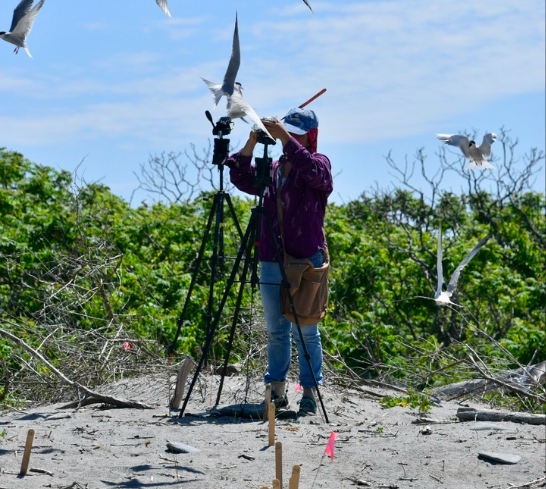Warming temperatures in the Gulf of Maine imperil seabirds by making it more difficult for them to find their preferred prey, forage fish like herring or hake. These prey have often passed through the region or are otherwise depleted by commercial fisheries by the time Common Terns need to access them for chick-rearing. As a result, annual reproductive success has been more variable over the last decade and notably lower in the last five years. Fewer chicks surviving means fewer adults breeding in the future, which could have repercussions for the continuity of this species.
We are beginning to understand the machinery of this issue, many thanks to cutting edge research performed across the country on seabird diet, as well as the ecology of their movement. Here’s a flow chart of what we know so far:

My work sits here (see below). How does basin-wide environmental change translate into colony-level reproductive outcomes?

To get at this question through the lens of social behavior, I have broken my research down into three broad questions:
What does aggression look like in Common Tern colonies in the Gulf of Maine? Aggression is well-documented in Common Terns. Burger and Gochfeld’s comprehensive book, The Common Tern, as well as the online database, Birds of the World, are two excellent resources for learning about the range of aggressive behaviors exhibited by terns. Enter a tern colony during the breeding season for even just a minute and you’ll learn what these behaviors look like firsthand. Whether it’s the tiniest head turn, a widening of the carpels, or a more obvious kyarr call – every movement means something.
We also know when birds will exhibit varying degrees of aggression. For example, the suite of aggressive behaviors directed by an older male at a younger male might be more intense than behaviors directed by that same bird to a younger female. Usually, the effect of covariate X (e.g., individual age or sex) on aggression intensity is determined by averaging the amount of aggression across pairs of individuals that differ based on X.
Two important gaps in knowledge emerge from this approach. First, by averaging pairwise interactions, these studies neglect an important facet of group-living in these colonies. That is, individuals are interacting across the habitat, often with more than one bird at the same time. Current techniques are not scalable to this more complex social landscape. Second, relating social aggression to population outcomes requires ecologically relevant behavioral information. The National Audubon Society Seabird Institute measures reproductive success at the colony-level, meaning that impact-driven behavioral research on these birds should shift towards identifying patterns across groups rather than within- or between-individual correlations.
To summarize – measuring Common Tern aggression across the habitat where it is taking place will capture the complexity of this social environment and make it compatible with existing ecological data in this system.
How does the environment affect patterns in aggression? I will also collect data on habitat structure, vegetation type, and feed rate to approximate the role of the environment in shaping patterns in aggression.
How do patterns in aggression influence reproductive outcomes across the colony? Productivity (chicks fledged per nest), hatch success (chicks hatched per number of eggs), and fledge success (chicks fledged per number of eggs), are already measured by the National Audubon Society Seabird Institute at designated plots around the islands they manage. I have complemented this work by measuring hatch success at individual nests in each of my research areas. Together, these metrics should allow me to elucidate potential correlations between patterns in aggression and reproductive success. Next year, I may incorporate physiological tests into my research scheme (e.g., corticosterone sampling) to better understand the mechanisms underpinning these correlations.
Return home.

